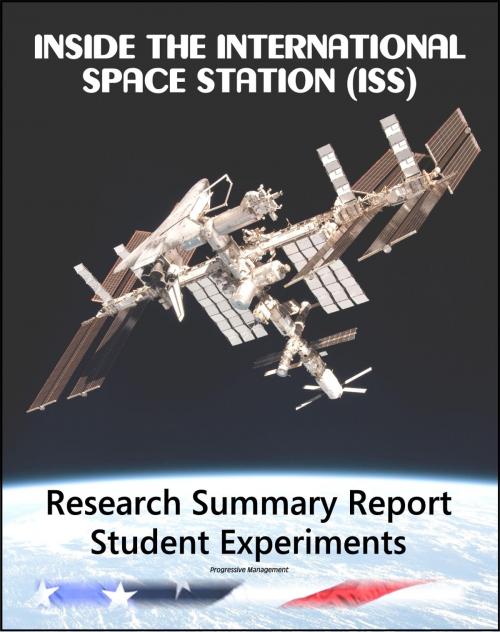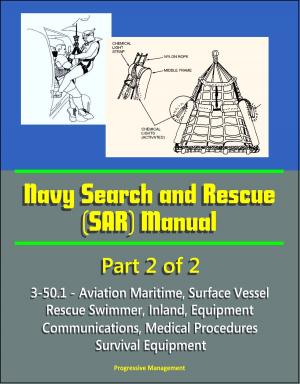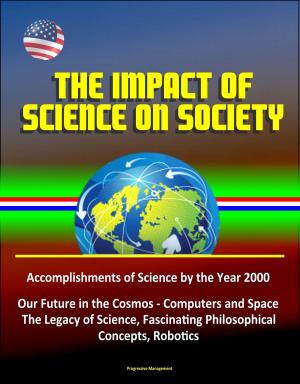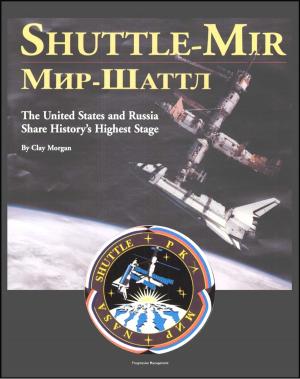Inside the International Space Station (ISS): Research Summary, Student Experiments, Educational Activities - Human Research for Exploration, Physical and Biological Sciences, Technology Development
Nonfiction, Science & Nature, Technology, Aeronautics & Astronautics, Science, Physics, Astrophysics & Space Science| Author: | Progressive Management | ISBN: | 9781476015439 |
| Publisher: | Progressive Management | Publication: | May 11, 2012 |
| Imprint: | Smashwords Edition | Language: | English |
| Author: | Progressive Management |
| ISBN: | 9781476015439 |
| Publisher: | Progressive Management |
| Publication: | May 11, 2012 |
| Imprint: | Smashwords Edition |
| Language: | English |
Two official NASA documents - converted for accurate flowing-text ebook format reproduction - provide detailed information on the experiments and research aboard the International Space Station (ISS).
The first document is titled International Space Station Research Summary Through Expedition 10. The launch of Expedition 1 to the International Space Station (ISS) opened a new chapter in the history of human space flight and international cooperation. Permanent human presence on board ISS began with the arrival of Bill Shepard, Sergei Krikalev, and Yuri Gidzenko on Nov 2, 2000. The first ten Expeditions marked a period of initial assembly, daily operations, and scientific activities. The completion of Expedition 10 on Apr 25, 2005 marked 1635 days (four and a half years) of continuous crewed operations. Although construction and maintenance of the space station has been the primary objective during these early years, a wide range of research projects has also been conducted on board ISS. Twenty-six astronauts and cosmonauts have occupied ISS through Expedition 10, with stays ranging from four to six months. Crewmembers of the first ten Expeditions have completed work on 85 formal U.S. experiments—some over multiple years and crews. Expedition crews conduct science daily across a wide variety of fields including human research, physical and life sciences, technology demonstrations, Earth observations, and education activities. This report summarizes the NASA research accomplishments on ISS through the first ten Expeditions. When the research programs for the early Expeditions were established, five administrative organizations were executing research on ISS: bioastronautics research, fundamental space biology, physical science, space product development, and space flight. The Vision for Space Exploration has led to changes in NASA's administrative structures, and so we have grouped experiments topically by their scientific themes, even when these do not correspond to the administrative structure at the time at which they were completed. The research organizations at the time at which the experiments flew are preserved in the appendix of this document.
The second document is Inspiring the Next Generation: Student Experiments and Educational Activities on the International Space Station, 2000-2006. Even before the Expedition 1 crew arrived at International Space Station (ISS) in November 2000, experiments with student participation were being conducted onboard ISS in support of the NASA mission. One of NASA's protein crystal growth experiments was delivered to station by space shuttle Atlantis during the STS-106 mission in September 2000, and was returned six weeks later aboard space shuttle Discovery during the STS-92 mission. Many of the protein samples that were flown had been prepared with the help of middle and high school students from across the country. From very early on it was thus recognized that students would have a strong interest in the ISS, and that this provided a unique opportunity for them to get involved and participate in science and engineering projects on the ISS. In the first five and a half years of continuous human presence on the ISS, a wide range of student experiments and educational activities has already been performed by the United States, the 16 International Partner countries officially participating in the International Space Station Program (ISSP), and a number of other countries under special commercial agreements. Many of these programs still continue, and others are being developed and added to the station tasks on a regular basis.
Two official NASA documents - converted for accurate flowing-text ebook format reproduction - provide detailed information on the experiments and research aboard the International Space Station (ISS).
The first document is titled International Space Station Research Summary Through Expedition 10. The launch of Expedition 1 to the International Space Station (ISS) opened a new chapter in the history of human space flight and international cooperation. Permanent human presence on board ISS began with the arrival of Bill Shepard, Sergei Krikalev, and Yuri Gidzenko on Nov 2, 2000. The first ten Expeditions marked a period of initial assembly, daily operations, and scientific activities. The completion of Expedition 10 on Apr 25, 2005 marked 1635 days (four and a half years) of continuous crewed operations. Although construction and maintenance of the space station has been the primary objective during these early years, a wide range of research projects has also been conducted on board ISS. Twenty-six astronauts and cosmonauts have occupied ISS through Expedition 10, with stays ranging from four to six months. Crewmembers of the first ten Expeditions have completed work on 85 formal U.S. experiments—some over multiple years and crews. Expedition crews conduct science daily across a wide variety of fields including human research, physical and life sciences, technology demonstrations, Earth observations, and education activities. This report summarizes the NASA research accomplishments on ISS through the first ten Expeditions. When the research programs for the early Expeditions were established, five administrative organizations were executing research on ISS: bioastronautics research, fundamental space biology, physical science, space product development, and space flight. The Vision for Space Exploration has led to changes in NASA's administrative structures, and so we have grouped experiments topically by their scientific themes, even when these do not correspond to the administrative structure at the time at which they were completed. The research organizations at the time at which the experiments flew are preserved in the appendix of this document.
The second document is Inspiring the Next Generation: Student Experiments and Educational Activities on the International Space Station, 2000-2006. Even before the Expedition 1 crew arrived at International Space Station (ISS) in November 2000, experiments with student participation were being conducted onboard ISS in support of the NASA mission. One of NASA's protein crystal growth experiments was delivered to station by space shuttle Atlantis during the STS-106 mission in September 2000, and was returned six weeks later aboard space shuttle Discovery during the STS-92 mission. Many of the protein samples that were flown had been prepared with the help of middle and high school students from across the country. From very early on it was thus recognized that students would have a strong interest in the ISS, and that this provided a unique opportunity for them to get involved and participate in science and engineering projects on the ISS. In the first five and a half years of continuous human presence on the ISS, a wide range of student experiments and educational activities has already been performed by the United States, the 16 International Partner countries officially participating in the International Space Station Program (ISSP), and a number of other countries under special commercial agreements. Many of these programs still continue, and others are being developed and added to the station tasks on a regular basis.















